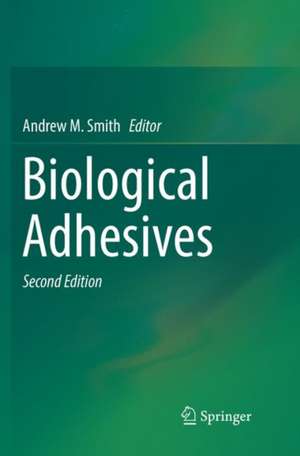Biological Adhesives
Editat de Andrew M. Smithen Limba Engleză Paperback – 23 iun 2018
| Toate formatele și edițiile | Preț | Express |
|---|---|---|
| Paperback (1) | 1058.91 lei 38-44 zile | |
| Springer International Publishing – 23 iun 2018 | 1058.91 lei 38-44 zile | |
| Hardback (1) | 1425.59 lei 38-44 zile | |
| Springer International Publishing – 2 noi 2016 | 1425.59 lei 38-44 zile |
Preț: 1058.91 lei
Preț vechi: 1393.31 lei
-24% Nou
Puncte Express: 1588
Preț estimativ în valută:
202.66€ • 211.02$ • 171.27£
202.66€ • 211.02$ • 171.27£
Carte tipărită la comandă
Livrare economică 06-12 martie
Preluare comenzi: 021 569.72.76
Specificații
ISBN-13: 9783319834351
ISBN-10: 3319834355
Pagini: 378
Ilustrații: VIII, 378 p. 95 illus., 49 illus. in color.
Dimensiuni: 155 x 235 mm
Greutate: 0.8 kg
Ediția:Softcover reprint of the original 2nd ed. 2016
Editura: Springer International Publishing
Colecția Springer
Locul publicării:Cham, Switzerland
ISBN-10: 3319834355
Pagini: 378
Ilustrații: VIII, 378 p. 95 illus., 49 illus. in color.
Dimensiuni: 155 x 235 mm
Greutate: 0.8 kg
Ediția:Softcover reprint of the original 2nd ed. 2016
Editura: Springer International Publishing
Colecția Springer
Locul publicării:Cham, Switzerland
Descriere
Many plants, animals, and microbes use adhesive polymers and structures to attach to inert substrates, to each other, or to other organisms. This is the first major review that brings together research on many of the well-known biological adhesives. Emphasizing the diversity of biological adhesives and associated adhesion processes, it deals with bacteria, fungi, algae, and marine and terrestrial animals. It bridges a variety of disciplines including biochemistry, molecular biology, biomechanics, bioengineering, microbiology, organism structure and function, and ultrastructure. As we learn more about the molecular and mechanical properties of these adhesives, we begin to understand why they adhere so well and how they develop cohesive strength. With this understanding comes the prospect of developing synthetic or semi-synthetic adhesives with broad applications in areas such as medicine, dentistry, and biotechnology. The book is suitable for both industrial and academic researchers.
Cuprins
Notă biografică
Andrew M. Smith
Professor
Ithaca College
Department of Biology
Specialty: Animal Physiology, Biomechanics
Phone (607) 274-3975
E-mail: asmith@ithaca.edu
Office: 155 Ctr for Natural Sciences
Ithaca, NY 14850
Professor
Ithaca College
Department of Biology
Specialty: Animal Physiology, Biomechanics
Phone (607) 274-3975
E-mail: asmith@ithaca.edu
Office: 155 Ctr for Natural Sciences
Ithaca, NY 14850
Textul de pe ultima copertă
This book reviews the structure of different biological adhesives and the mechanisms by which they achieve interfacial adhesion, cohesive strength, and fracture toughness. These adhesives include cements, strongly adherent fibrous holdfasts, tough and flexible adhesive gels, energy-dissipating adhesive tapes, nanoparticle-based adhesives, hierarchically structured nanoarray adhesives and a wide variety of viscous, sticky secretions.
Biological adhesives are complex biomaterials that have evolved to meet a wide variety of functional demands, and which range from the micro- to the macro-scale. Some adhesives set rapidly, while others set over longer periods of time; others can readily detach and reattach to allow movement and to manipulate objects, while yet others have the ability to self-heal after sustaining damage.
Recent technological advances have expanded our ability to characterize these materials. Analyzing the physical and molecular structure, processing, chemical interactions and mechanical properties of these adhesives has yielded novel insights, which this new edition discusses in detail. These insights are likely to inform and guide the biomimetic development of new, powerful adhesives with desirable properties that are unmatched by today’s synthetic adhesives. Given the breadth and depth of its coverage, the book offers an invaluable source of information for industrial and academic researchers alike.
Biological adhesives are complex biomaterials that have evolved to meet a wide variety of functional demands, and which range from the micro- to the macro-scale. Some adhesives set rapidly, while others set over longer periods of time; others can readily detach and reattach to allow movement and to manipulate objects, while yet others have the ability to self-heal after sustaining damage.
Recent technological advances have expanded our ability to characterize these materials. Analyzing the physical and molecular structure, processing, chemical interactions and mechanical properties of these adhesives has yielded novel insights, which this new edition discusses in detail. These insights are likely to inform and guide the biomimetic development of new, powerful adhesives with desirable properties that are unmatched by today’s synthetic adhesives. Given the breadth and depth of its coverage, the book offers an invaluable source of information for industrial and academic researchers alike.
Caracteristici
A fully revised and expanded new edition
Now also covers adhesives from mussels, spiders and ivy
Of great interest for applications in medicine, dentistry, and biotechnology
Now also covers adhesives from mussels, spiders and ivy
Of great interest for applications in medicine, dentistry, and biotechnology












